On May 6, 2012, I defoliated my Korean hornbeam. Here is what it looked like after removing the leaves.
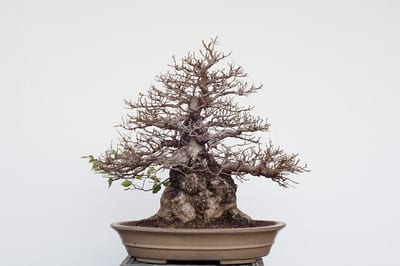
Defoliated – May 6 (the few leaves in back belong to an escape branch)
One of my main goals for defoliating the tree was to expose the interior buds to more light (see Decandling a Korean hornbeam for details). When interior buds receive more light, they become stronger. Making the interior buds stronger creates greater balance between interior and exterior shoots.
Of course, removing all of a tree’s foliage is a very stressful procedure – for me and the tree! I’ve owned this tree for a number of years and I know it’s in good soil and in good health. Had I any reservations about the tree’s health, I would not have defoliated it.
To track the tree’s progress, I took photographs every two weeks for 10 weeks – here’s what happened.
After two weeks, about half of the tree’s buds had started growing. What I found interesting about this was that the interior buds – the previously weak buds – were growing faster than the exterior buds. This surprised me and made me happy as I was hoping the procedure would strengthen the interior buds, though I would not have predicted they would start off so strong.
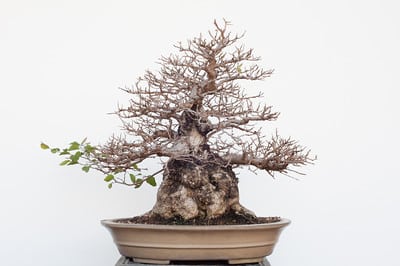
2 weeks later – May 20
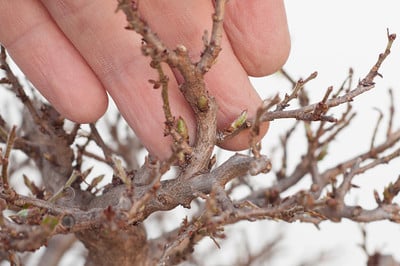
2 weeks later – May 20: note large buds at the base of this branch
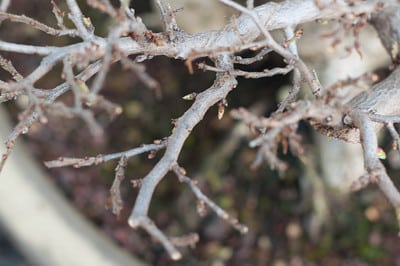
2 weeks later – May 20: the interior buds lead the way
As there wasn’t much foliage on the tree, it dried out fairly slowly between waterings, even in the full sun. I only watered when the tree got dry, maybe every 2-3 days, depending on the weather.
Two weeks later – one month after defoliating – it became very clear that the tree was investing a lot of energy in these interior buds. The tree looked awkward at this point, but it was growing quickly.
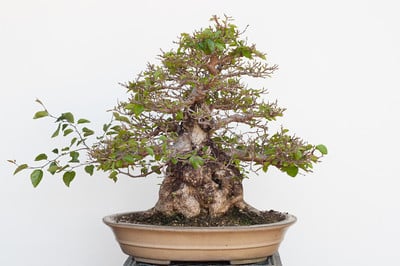
4 weeks later – June 3
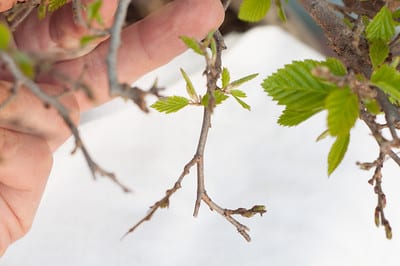
4 weeks later – June 3: note small leaves in the interior
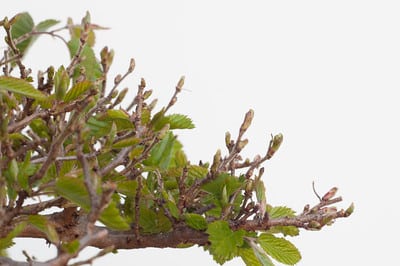
4 weeks later – June 3: clear shot of interior buds developing ahead of exterior buds
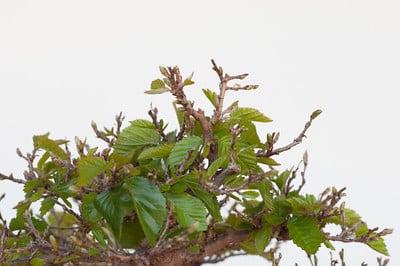
4 weeks later – June 3: even the apex is slow
The momentum that these interior buds displayed early on carried through the following weeks. Six weeks after defoliating, the tree was beginning to fill out, and even the exterior buds were now opening.
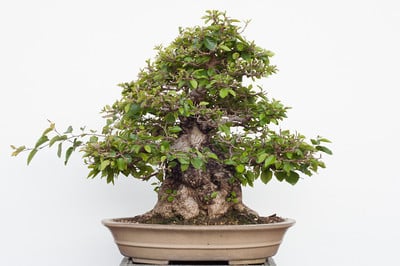
6 weeks later – June 18
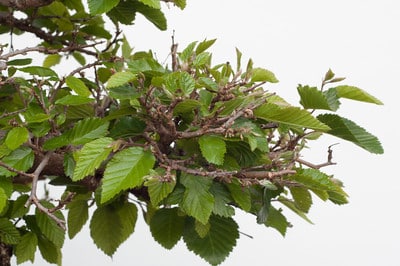
6 weeks later – June 18: exterior buds beginning to open
As the tree neared the two-month mark after being defoliated, the strongest new shoots began elongating – a great sign of health. The tree was still not as full as it was in May, however, which isn’t necessarily a bad thing. The open areas between branches ensured that light reached the interior shoots – light needed to keep these shoots healthy.
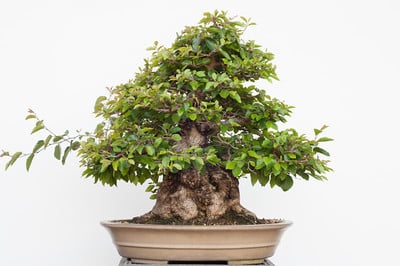
8 weeks later – June 30
It was also around this time it became clear that some of the weakest branches didn’t make it. To prevent this from happening in the future, I can partially defoliate the tree, leaving the leaves on weak branches alone.
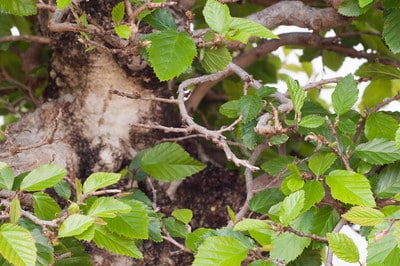
8 weeks later – June 30: a defoliation casualty
By this point, the strongest shoots were gaining a lot of vigor, leaving the tree’s silhouette in places and accelerating quickly – time to cut again!
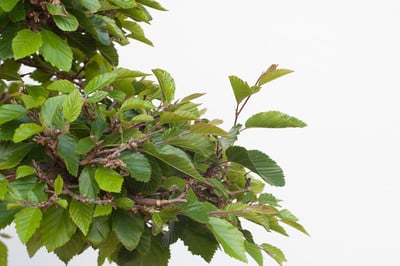
8 weeks later – June 30: the strongest new shoot
The changes in the last two weeks were subtle. More shoots began accelerating away from the silhouette, and the tree once again appeared full, if not as full as it appeared in spring.
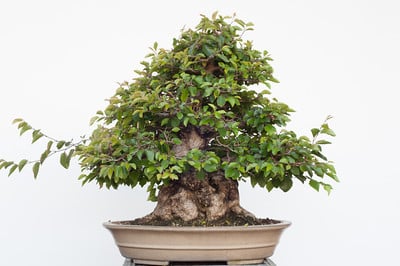
10 weeks later – July 14
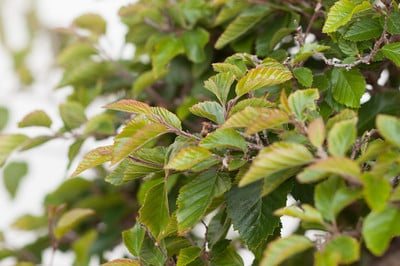
10 weeks later – July 14: healthy new growth
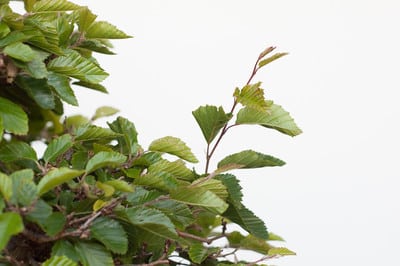
10 weeks later – July 14: the longest shoot gets longer
I’m happy, and somewhat relieved, that the tree recovered as well as it did. I’ll have a better idea about the overall effect on the tree when the leaves come off in fall and I can get a good look at the interior branches. If all is well, I may try partially defoliating the tree next year. In the meantime, I’ll keep watering and fertilizing and clipping the multiplying shoots that are popping-up all over.
Subscribe to Bonsai Tonight
New Posts Delivered Every Tuesday and Friday
Scott Roxburght Roxburgh says
Awesome progression, Jonas.
I have only one Hornbeam but it is not as advanced (or strong) as yours. I’ll keep this bookmarked for the future.
Michael Pollock says
Great series on this. Going to have to try this on mine next year.
Dick van Dreven says
Jonas,
Quite a suprising result. I think defenitly a result that very much improves your tree. thanks very much for sharing.
Dick van Dreven
Graham says
Hi Jonas, a great article.
My “in training” hornbeam (still in a large plastic container) was defoiated when I missed watering for a few days during a hot spell a few weeks back, most interior branches lost their leaves but have reflushed (whew)….my question to you is what type of fertilizer are you using on yours?
Cheers
Graham
Jonas Dupuich says
Thanks Graham – I’m glad to hear your tree came back. As for fertilizer, I use fish emulsion and cottonseed meal for all of my trees, and sometimes imported dango.
Cheers,
Jonas
Brian VF says
Great results. I did mine last year and it was a nail-biting few weeks. It wasn’t really atrong when it came back, so I’m hopeful after seeing this. Thwanks for sharing!
Steve Moore says
Very interesting! Have you any thoughts as to why the interior buds developed first?
I wonder, too, if the same response would be seen in other deciduous broadleaves, like maples.
Jonas Dupuich says
Hi Steve – my guess is that stressed trees send energy to the buds closest to the trunk rather than the buds furthest from the trunk. Whether that’s due to efficiency or an effort to focus the investment on the most protected areas I don’t know.
Kang Usep says
nice job……good luck…..